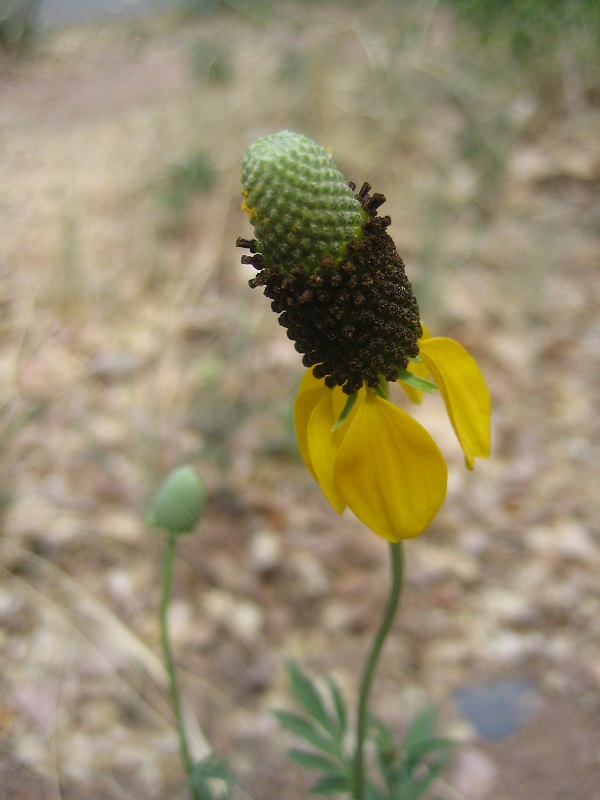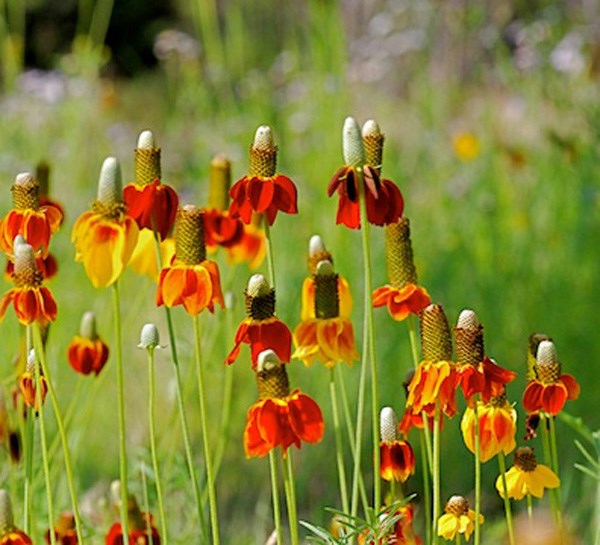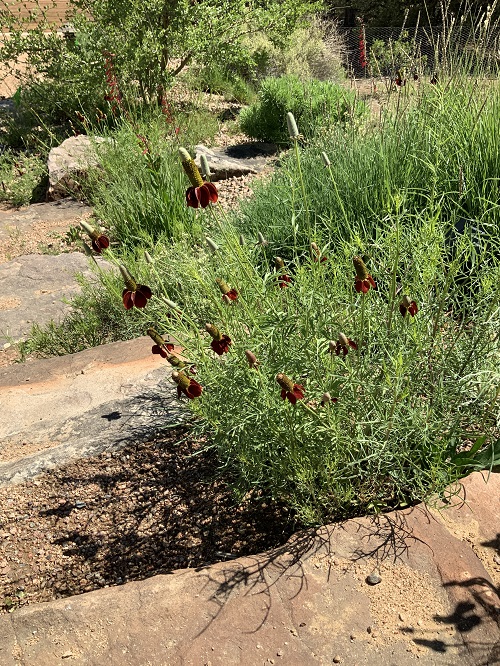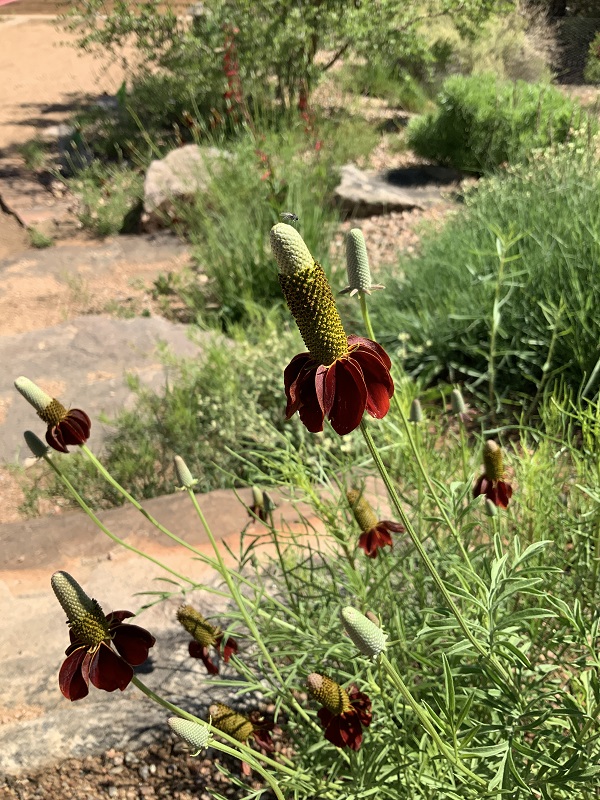Scientific name: Ratibida columnifera
Common names: prairie coneflower, Mexican Hat
Family: Asteraceae
Article by Peggy Rudberg
In July 2021, after a month of abundant rain, we came upon a field resplendent with wildflowers in Arroyo Chamisa, about two miles south of St. John’s College. Prairie coneflowers, Ratibida columnifera, were especially copious. They are also called Mexican hats due to their resemblance to sombreros with their high crowns and brim-like rays. The colors too, golden yellow to rich rusty maroon, echo the hues found in marigolds, the flowers of Mexican Day of the Dead.

Photo: Peggy Rudberg
Prairie coneflowers are members of the Asteraceae family, the largest family of angiosperms (flowering plants) in North America with over 23,000 species worldwide. Asteraceae or Compositae, the original family name, have distinctive inflorescences of composite flowers. Composite flowers are actually a group of many tiny flowers called florets that look like one flower. And many Asteraceae have 2 different types of flowers on the same flower head, disc flowers and ray flowers. In the prairie coneflower smaller disc flowers made up of cylindrical florets are on the cone in the center. Columnifera means column shaped. Looking like large petals, individual ray flowers encircle the lower outer edge of the cone to attract pollinators. The drooping ray flowers are sterile and colors vary from solid yellow or maroon to bicolor with contrasting margins. Several hundred bisexual disc florets on the long central cone of the flower head hold the reproductive parts. As they mature the disc florets open from the bottom to the top of the cone, looking a bit like small pinecones. Each floret produces one seed that ripens in the fall to be scattered by the wind for reseeding and for songbirds and small mammals to enjoy. Crushed mature seed heads give off a licorice smell. The flower heads are found on tall erect stalks up to three feet high with alternate slender pinnately lobed leaves denser towards the bottom of the plant.

Photo: Janice Tucker
Prairie coneflowers are herbaceous perennial natives found from zones 4-9 in the southern provinces of central and eastern Canada, the central and mountainous United States and northern Mexico. Although they are common in the prairies, they also succeed in the drier, alkaline, low fertility soils of Santa Fe, as long as the soil is well drained. They are clump forming, tap rooted, xeric and pest free and respond best to full sun. Ratibida columnifera are easy to propagate from seeds placed at a depth of 1⁄4 to 1⁄2 inch preferably in spring or from divided rootballs. If seeds find their way to disturbed areas like roadsides they will take up residence. They are fast growing and generally bloom prolifically from June into fall but will not flower until their second year. You can extend blooming if you routinely deadhead.

Prairie coneflower in Garden.
At the Santa Fe Botanical Garden they are located around the pavilion planting area. In the wild they often spread to create colorful meadows attracting bees and butterflies. They can even provide some forage, as they are palatable to grazing animals. Native Americans used a prairie coneflower decoction of leaves and stems for stomachaches and poison ivy relief and boiled flower heads in water to produce headache remedies and an orange-yellow dye.
Prairie coneflowers are included in a low water “habitat kit” of native perennial wildflowers distributed by the Xerces Society for Invertebrate Conservation, an international nonprofit organization that protects the natural world through the conservation of invertebrates and their habitats. Xerces’ key program areas are pollinator conservation, endangered species conservation, and reducing pesticide use. The Society has established a Santa Fe Pollinator Trail creating a corridor of local patches of native vegetation that supply food and shelter for pollinators as they traverse or migrate through our urban environment. Sites have been selected to improve connectivity. The kits have been adopted by gardeners and organizations that have agreed to cultivate and maintain the plants in a pesticide free environment. The transplants, grown by Santa Ana Native Plant Nursery, offer climate-smart spring to fall flowering plants attractive to bees, butterflies and other beneficial insects. Ratibida columnifera is also recommended on the city of Santa Fe’s “Drought Tolerant Plant List.” With wild bees and other native pollinators on the decline, sustaining them is crucial to the health of our environment.

References
Bebeau, G.D. “Ratibida columnifera (Nutt.) Woot. & Standl.” Friends of the Wild Flower Garden, Inc. c.2013. Web. 9 June 2022. Retrieved from: https://www.friendsofthewildflowergarden.org/pages/plants/prairieconeflower.html
“Composite Flowers – Asteraceae.” Cronodon. 2 June 2022. Web. 9 June 2022. Retrieved from: https://cronodon.com/BioTech/asteraceae.html
Haase, Kaitlin. “New in Santa Fe: Pollinator Trail and Habitat Kit Program.” Xerces Society for Invertebrate Conservation. 9 April 2021. Web. 9 June 2022. Retrieved from: https://xerces.org/blog/new-in-santa-fe-pollinator-trail-and-habitat-kit-program
“Ratibida columnifera (Nutt.) Woot. & Standl.” Native Plants Database. Lady Bird Johnson Wildflower Center. 8 Dec. 2018. Web. 9 June 2022. Retrieved from: https://www.wildflower.org/plants/result.php?id_plant=ANCA10.


